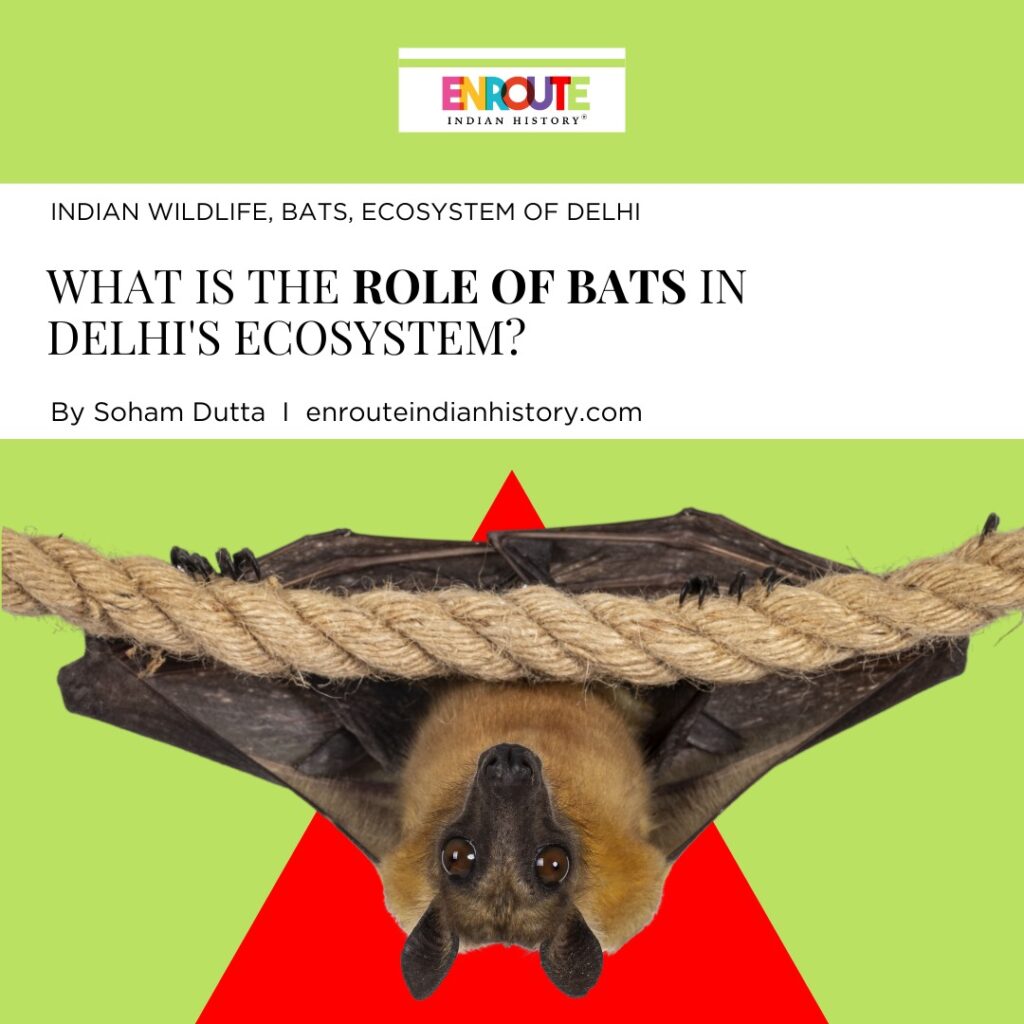
Bats were among the many urban animals that formerly called the Aravalli woodland home. Nonetheless, many animals lost their habitats as a result of human settlements. However, bats in Delhi and the NCR have adjusted to their new environment and are now thriving. These flying mammals have found Delhi’s abundant vegetation to be a perfect place to set their nests and help maintain ecological harmony. When it comes to bats, city dwellers have a mixed attitude. Negative perceptions and assumptions about these creatures are unfortunately common. Having said that, their pivotal function in managing insect populations makes them both economically significant and a prominent conservation goal. Understanding the variety of these organisms and how they work together in harmony is crucial, as is spreading knowledge about them and debunking misconceptions.

A small group of naked-backed tomb bats (Taphozous nudiventris) in a chamber in Qutub Minar area in New Delhi. Photo by J. Rydell,MDPI, 2018
Diversity of Bats in Delhi
The city of Delhi, India, boasts a diverse range of flora and fauna, including a significant population of bats belonging to the order Chiroptera. Despite increasing development and urbanization in this region, some species of bats have demonstrated an ability to adapt to urban environments, utilizing them as new roosting habitats to acquire new resources and benefits. These findings suggest that certain bat species can survive alongside humans in our modern world, despite the challenges posed by urbanization. In addition to birds, which are known to use Delhi as their breeding ground, bats are a noteworthy nocturnal mammal group that contributes to the city’s biodiversity.
There are an estimated 13 different species of bats in the Delhi-NCR, including fruit and insectivorous bats. The Indian Flying Fox, Short-nosed Fruit Bat, Fulvous Fruit Bat, Mouse-tailed Bat, Indian Pipistrelle, and Least Pipistrelle are the most prevalent species. Being the center of the Mughals and Delhi Sultanate, the city has a rich architectural background that is reminiscent of bat colonies. The suburb of Lutyens in Delhi has a lot of trees, which contributes to its high bat density. One of the biggest bats in the world, the Indian Flying Fox, is often seen hovering about Rashtrapati Bhavan, India Gate, and Bangla Sahib Gurudwara. Because they are either nectar- or frugivorous, flying foxes are dependent on the survival of trees. Bats use the old-growth trees in Lutyens’ Delhi as roosting places; the Arjun, Ashoka, and Jamun trees are the main species that provide these habitats.

A greater mouse-tailed bat (Rhinopoma microphyllum) in a dark chamber in the Khirki Mosque, NewDelhi. Photo by J. Rydell,MDPI, 2018
Ecological Contributions of Bats
Bats play an important part in preserving natural equilibrium by controlling insect populations, pollinating flowers, and distributing seeds. However, the influence of their feeding habits on most bat species is poorly known, making conservation efforts problematic. They are effective pollinators and seed dispersers for a variety of fruits, including bananas, figs, mangoes, cashews, and agave. Some trees in Delhi, including Crescentia spp., Haplophragma spp., and Kigelia spp., rely on bat pollination. Another realm in which bats are helpful is that of Pest control. The usage of chemical pesticides in agriculture has skyrocketed over the last several decades, which is unsustainable and harmful to food crops. Other biological pest management methods are being explored, such as mating disruption with pheromones or sterile males. However, these biological agents account for a minor part of the alternatives now available on the market. As multi-resistant bugs emerge, natural pest control agents such as bats will become increasingly important, while chemical control becomes less effective. Although the economic worth of bats’ ecosystem services in India has yet to be determined, rising data from other areas indicates that bats are important nuisance bug eaters with the capacity to reduce or control populations.
Bat’s and their symbiotic relationship with Delhi’s Monument’s
Historical sites in India and around the world hold significant cultural and historical value. They also provide habitats for diverse wildlife, including bats. A team from Lund University and Guru Gobind Singh Indraprastha University visited five locations, including the Agrasen ki Baoli stepwell and four Mughal-era mosques or forts. During the exploration, they found that numerous worshippers shared spaces with thousands of bats inside vaults and chambers in Feroz Shah Kotla’s Jami Masjid. Similarly, even after recent renovations and external lighting installation at the Qutub complex, some tomb bats still prefer the darker chambers. Zafar Mahal, constructed during the Mughal Empire’s decline, features dimly lit rooms and vaults that possibly serve as habitats for bats. On the other hand, Khirki Mosque, another significant Mughal structure, lacks lighting due to urban encroachment, which also makes it a habitat for bats.

A group of lessr-mouse-tailed bats (Rhinopoma hardwickii) in Zafar Mahal in New Delhi. Photo by J.Rydell,MDPI,2018
Bats are drawn to structures with dim, quiet vaults or chambers, which are crucial for their habitat. Their preference for dark environments serves as a defense against predators. Additionally, proximity to feeding areas also influences their choice. Despite being in urban settings, bats travel distances of 2-5 kilometers to agricultural fields for nightly feeding. Interestingly, mouse-tailed bats at Feroz Shah Kotla mosque tolerate tourists, even at close range, as long as they are left undisturbed. They are considered a natural part of the environment, unlike encounters with torches and cameras, which provoke defensive reactions.
This adaptability is linked to what scholars term “synanthropization,” where animal populations adapt to human-induced conditions. However, fruit bats in India exhibit limited synanthropic behavior. The Indian flying fox, one of the world’s largest bat species, feeds on fruits or nectar. During the breeding season from July to October, females carry pups and they are nocturnally active and roost near water sources. In Delhi, they can be seen fluttering during summer and huddling for warmth in winter.

Part of a colony of greater mouse-tailed bats (R. microphyllum) in the Feroz Shah Kotla mosque in New Delhi. The tight clustering is a defensive behavior in response to our disturbance with torch and camera. Interestingly, the bats never responded in this way to the crowd of worshippers just a meter or two away. Photo by J. Rydell,MDPI,2018
Conservation and Increasing Awareness
Bats are a vital part of the ecosystem, but they’ve been subjected to mistreatment and myths throughout history. Many people believe that bats all carry rabies and that they are blind. Another common misconception is that bats drink human blood and can turn people into vampires. These myths are often perpetuated by popular culture, leading people to have incorrect ideas about bats. This has resulted in many people considering bats as pests, and they have been classified as such under the Indian Wildlife (Protection) Act of 1972. These misconceptions are harmful to bats and make people underestimate their importance in nature.

The Wildlife SOS Rapid Response Unit has rescued numerous bats in the past from across Delhi-NCR, by Kunal Sharma, Wildlife SOS,2023
Recent developments have brought about a positive shift in public opinion, leading to an increased willingness to collaborate with Wildlife SOS in rescuing bats from various locations in Delhi. The management of old monuments in Delhi presents a complex issue that requires careful consideration of the need to promote tourism, protect the well-being of bats living there, and utilize their potential to control pests in nearby agricultural fields. Bats are essential components of historical structures and should be accorded the respect they deserve, particularly because they tend to roost in such places for extended periods.
References
- Mishra, Rajlakshmi. “Fruit Bats: The Dark Knights of Lutyens’ Delhi.” Mintlounge, 20 Mar. 2018, lifestyle.livemint.com/news/talking-point/fruit-bats-the-dark-knights-of-lutyens-delhi-111645456468653.html.
- Banerjee, Neellohit. “Batting an Eye for the Nocturnal Residents of Delhi – Wildlife SOS.” Wildlife SOS, 18 Mar. 2023, wildlifesos.org/rescue/batting-an-eye-for-the-nocturnal-residents-of-delhi/#:~:text=Delhi%20is%20home%20to%20both,Indian%20Pipistrelle%20and%20Least%20pipistrelle.
- Dookia, Sumit. (2015). Bats of Delhi. Small Mammals Mail.
- Umadi, Ravi, et al. “The Monumental Mistake of Evicting Bats From Archaeological Sites—A Reflection From New Delhi.” Heritage, vol. 2, no. 1, MDPI AG, Feb. 2019, pp. 553–67. Crossref, https://doi.org/10.3390/heritage2010036.

























